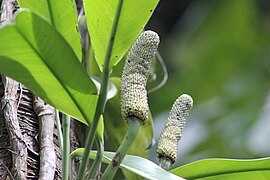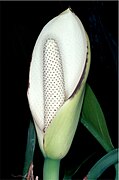| Needle berry | |
|---|---|

| |
| In rainforest near Cape Tribulation | |
| Conservation status | |
| Least Concern (NCA) | |
| Scientific classification | |
| Kingdom: | Plantae |
| Clade: | Tracheophytes |
| Clade: | Angiosperms |
| Clade: | Monocots |
| Order: | Alismatales |
| Family: | Araceae |
| Genus: | Rhaphidophora |
| Species: | R. australasica |
| Binomial name | |
| Rhaphidophora australasica F.M.Bailey | |
| Synonyms | |
Rhaphidophora australasica, commonly known as needle berry, is a plant in the arum family Araceae that is only found in the Wet Tropics bioregion of northeastern Queensland, Australia. It is a semi-epiphytic, robust, herbaceous, root climber reaching about 30 m (98 ft) tall. The dark green leaves are oblanceolate to elliptic and measure up to 40 cm (16 in) long by 14 cm (5.5 in) wide. The inflorescence is a spadix about 6–8 cm (2.4–3.1 in) long, enclosed in a spathe about 13 cm (5.1 in) long.
Taxonomy
This species was first described in 1897 by the Australian botanist Frederick Manson Bailey, and published in the Queensland Agricultural Journal.
Distribution and habitat
The needle berry occurs in rainforest from around Cooktown south to about Ingham, at altitudes from sea level to about 1,000 m (3,300 ft).
Conservation
This species is listed by the Queensland Government's Department of Environment, Science and Innovation as least concern. As of 1 April 2024, it has not been assessed by the International Union for Conservation of Nature (IUCN).
Gallery
References
- ^ "Species profile—Rhaphidophora australasica". Queensland Department of Environment and Science. Queensland Government. 2022. Retrieved 1 March 2024.
- ^ "Rhaphidophora australasica". Australian Plant Name Index (APNI). Centre for Australian National Biodiversity Research, Australian Government. Retrieved 1 April 2024.
- ^ "Rhaphidophora australasica F.M.Bailey". Plants of the World Online. Royal Botanic Gardens, Kew. 2024. Retrieved 1 April 2024.
- ^ Hay, A. (2022). "Rhaphidophora australasica". Flora of Australia. Australian Biological Resources Study, Department of Climate Change, Energy, the Environment and Water: Canberra. Retrieved 1 April 2024.
- ^ F.A.Zich; B.P.M.Hyland; T.Whiffen; R.A.Kerrigan (2020). "Rhaphidophora australasica". Australian Tropical Rainforest Plants Edition 8 (RFK8). Centre for Australian National Biodiversity Research (CANBR), Australian Government. Retrieved 1 April 2024.
External links
- View a map of herbarium collections of this species at the Australasian Virtual Herbarium
- View observations of this species on iNaturalist
- View images of this species on Flickriver.com



